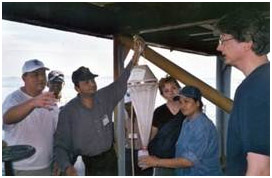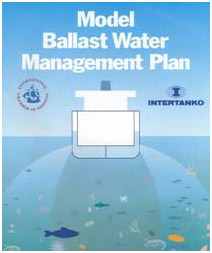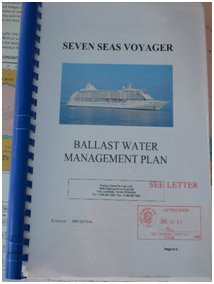The Response > The BWM Convention and its Guidelines
The International Convention for the Control and Management of Ships Ballast Water & Sediments was adopted by consensus at a Diplomatic Conference at IMO in London on Friday 13 February 2004. The Conference was attended by representatives of 74 States, one Associate Member of IMO; and observers from two intergovernmental organizations and 18 non-governmental international organizations.
The Convention is divided into Articles and an Annex which includes technical standards and requirements in the Regulations for the control and management of ships’ ballast water and sediments. To complement the Convention the IMO adopted over 15 sets of guidelines and other documents contained in MEPC resolutions and circulars. The main features of the Convention are outlined below.

IMO Diplomatic Conference, February 2004.
Preamble
The Preamble to the Convention refers to the 1992 United Nations Conference on Environment and Development (UNCED) and its request that IMO develop rules on ballast water discharge; the need for a precautionary approach called for by Principle 15 of the “Rio Declaration on Environment and Development”; States’ obligations under UNCLOS to prevent the spread of alien species; and the conservation and sustainable use of marine biodiversity obligations under the “Convention on Biological Diversity” regime and to the 2002 World Summit on Sustainable Development (WSSD).
This Preamble firmly connects the issue and the Convention to the IMO regulatory strategy regarding ship safety, cleaner seas and internationally agreed upon standards. It also clearly links it with the sustainable development agenda and integrated management practices advocated at UNCED and at WSSD, reflecting the increasing integration of activities amongst the various UN agencies.
Entry into force
The Convention will enter into force 12 months after ratification by 30 States, representing 35 per cent of world merchant shipping tonnage (Article 18 Entry into force). For the current status of the BWM Convention please visit the IMO’s website at www.imo.org/About/Conventions/StatusOfConventions.
General Obligations
Under Article 2 General Obligations Parties undertake to give full and complete effect to the provisions of the Convention and the Annex in order to prevent, minimize and ultimately eliminate the transfer of harmful aquatic organisms and pathogens through the control and management of ships’ ballast water and sediments.
Parties are given the right to take, individually or jointly with other Parties, more stringent measures with respect to the prevention, reduction or elimination of the transfer of harmful aquatic organisms and pathogens through the control and management of ships’ ballast water and sediments, consistent with international law. Parties should ensure that ballast water management practices do not cause greater harm than they prevent to their environment, human health, property or resources, or those of other States.
Application
According to Article 3, the BWM Convention applies to all ships including submersibles, floating craft, floating platforms, FSUs and FPSOs. It will not apply to:
- ships not designed to carry ballast water
- warships, naval auxiliary ships or other ships owned or operated by a state
- ships only on non-commercial service, or
- ships with permanent ballast water in sealed tanks.
Reception facilities
Under Article 5, Sediment Reception Facilities, Parties undertake to ensure that ports and terminals where cleaning or repairs of ballast tanks occurs have adequate reception facilities for the reception of sediments. The IMO Guidelines for Sediment Reception Facilities (G1) provide guidance for the provision of facilities for the reception of sediments from ballast water tanks.
In addition, Regulation B-3.6 provides that the requirements of ballast water management standards do not apply to ships that discharge ballast water to a reception facility. The IMO Guidelines for Ballast Water Reception Facilities (G5) provide for guidance for the provision of facilities for the reception of ballast water.
Research and monitoring
Article 6 Scientific and Technical Research and Monitoring calls for Parties individually or jointly to promote and facilitate scientific and technical research on ballast water management; and monitor the effects of ballast water management in waters under their jurisdiction.

A scientific team collecting ballast water from a ship’s tanks
Violations of requirements
Under Article 8 Violations, a Party, including in its capacity as a flag State, shall prohibit, under its law, violations to the requirements of the convention and establish sanctions. Two situations are addressed:
Wherever the violation occurs: when the administration of the Flag of the ship is informed about a violation, it shall investigate the allegation. When sufficient evidence of the violation is provided, the administration shall cause proceedings as soon as possible according to its law.
Violation occurring within the jurisdiction of a Party, this Party shall inform the administration of the ship concerned and provide evidence of the violation that may be in its possession.
Survey, certification and inspection
Ships are required to be surveyed and certified (Article 7 Survey and certification) and may be inspected by port State control officers (Article 9 Inspection of Ships) who can verify that the ship has a valid certificate; inspect the Ballast Water Record Book; and/or sample the ballast water. If there are concerns, then a detailed inspection may be carried out and “the Party carrying out the inspection shall take such steps as will ensure that the ship shall not discharge Ballast Water until it can do so without presenting a threat of harm to the environment, human health, property or resources”. All possible efforts shall be made to avoid a ship being unduly detained or delayed (Article 12 Undue Delay to Ships).
Technical assistance
Under Article 13 Technical Assistance, Co-operation and Regional Co-operation, Parties undertake, directly or through the Organization and other international bodies, as appropriate, in respect of the control and management of ships’ ballast water and sediments, to provide support for those Parties which request technical assistance to train personnel; to ensure the availability of relevant technology equipment and facilities; to initiate joint research and development programmes; and to undertake other action aimed at the effective implementation of this Convention and of guidance developed by the Organization related thereto.
ANNEX
The Annex is divided into five Sections.
Section A: General Provisions
Under Regulation A-2, General Applicability, it is stated that except where expressly provided otherwise, the discharge of ballast water shall only be conducted through ballast water management, in accordance with the provisions of the Annex to the Convention.
Regulation A-3, Exceptions, sets exceptions to the general principle above, such as the need to ensure the safety of a ship in emergency situations or saving life at sea, accidental discharges resulting from a damage to a ship or to its equipment, the need to avoid or minimize pollution incidents from the ship, the situation where the uptake and discharge of ballast water and sediment are taking place in the high seas or if the uptake and discharge of ballast water and sediment originate from the same location.
Regulation A-4, Exemptions, provides that a Party, under certain conditions, may grant exemptions to ballast water management requirements to ships which only operate between specified ports or locations. The IMO Guidelines for Risk Assessment under Regulation A-4 of the BWM Convention (G7) provide advice and information regarding risk assessment principles, methods and procedures for granting exemptions.
Under Regulation A-5, Equivalent Compliance, the Flag administration can issue equivalent compliance, under certain conditions, to pleasure craft. In doing so, the administration shall take the IMO Guidelines for Ballast Water Management Equivalent Compliance (G3).
Section B: Management and Control Requirements for Ships
Ships are required to have on board and implement a Ballast Water Management Plan approved by the Administration (Regulation B-1). The Ballast Water Management Plan is specific to each ship and includes a detailed description of the actions to be taken to implement the Ballast Water Management requirements and supplemental Ballast Water Management practices.
A BWMP must:
- assist the ship in complying with international regulations to minimise the risk of the transfer of harmful aquatic organisms and pathogens in ships’ ballast water and associated sediments
- identify the ship’s Ballast Water Management Officer
- consider ship safety elements, provide information to PSC officers on the ship’s ballast handling system and confirm that ballast water management can be effectively planned
- include training on BWM operational practices
- be written in the working language of the ship. If this language is not English, French or Spanish a translation into one of these It is important to note that MEPC 63 agreed that whilst the Guidelines adopted after 2004 for the uniform implementation of the BWM Convention have effectively superseded the Guidelines adopted by resolution A.868(20), for practical reasons, the Ballast Water Management Plans, approved in accordance with resolution A.868(20), should remain valid until they require revision due to the installation of a ballast water management system.


Ships must have a Ballast Water Record Book (Regulation B-2) to record when ballast water is taken on board; circulated or treated for Ballast Water Management purposes; and discharged into the sea. It should also record when Ballast Water is discharged to a reception facility and accidental or other exceptional discharges of Ballast Water.
Ballast Water Management for Ships
The specific requirements for ballast water management are contained in regulation B-3 Ballast Water Management for Ships:
- Ships constructed before 2009 with a ballast water capacity of between 1500 and 5000 cubic metres must conduct ballast water management that at least meets the ballast water exchange standard (D-1) or the ballast water performance standard (D-2) until 2014, after which time it shall at least meet the ballast water performance standard.
- Ships constructed before 2009 with a ballast water capacity of less than 1500 or greater than 5000 cubic metres must conduct ballast water management that at least meets the ballast water exchange standards or the ballast water performance standards until 2016, after which time it shall at least meet the ballast water performance standard.
- Ships constructed in or after 2009 with a ballast water capacity of less than 5000 cubic metres must conduct ballast water management that at least meets the ballast water performance standard.
- Ships constructed in or after 2009 but before 2012, with a ballast water capacity of 5000 cubic metres or more shall conduct ballast water management that at least meets the ballast water performance standard.
- Ships constructed in or after 2012, with a ballast water capacity of 5000 cubic metres or more shall conduct ballast water management that at least meets the ballast water performance standard.
Other methods of ballast water management may also be accepted as alternatives to the ballast water exchange standard and ballast water performance standard, provided that such methods ensure at least the same level of protection to the environment, human health, property or resources, and are approved in principle by IMO’s Marine Environment Protection Committee (MEPC).
Because there were uncertainties on the immediate availability of ballast water treatment technology to ships to which regulation B-.3.3 would first apply, i.e. ships constructed in 2009, the IMO Assembly adopted, on 29 November 2007, Resolution A.1005(25) with the aim of postponing the starting date (1st January 2009) set in the Convention for the application of the Regulation D-2 standard. The Resolution established a new deadline, that is, 1st January 2012. In the Resolution, the IMO Assembly recommended that States ratifying the Convention should join with their instrument of ratification a declaration or otherwise communicate to the Secretary-General their intention to apply the Convention on the basis of the following understanding:
“A ship subject to regulation B-3.3 constructed in 2009 will not be required to comply with regulation D-2 until its second annual survey, but no later than 31 December 2011”.
In November 2013, the IMO Assembly approved resolution A.1088(28) on the application of regulation B-3 of the BWM Convention to ease and facilitate the smooth implementation of the Convention. The resolution recommends that ships constructed before the entry into force of the Convention will not be required to comply with regulation D-2 until their first renewal survey following the date of entry into force of the Convention. The aim of the resolution is to clarify uncertainty in relation to the application of regulation B-3, through the application of a realistic timeline for enforcement of regulation D-1 and regulation D-2, upon entry into force of the Convention.
Under Regulation B-4 Ballast Water Exchange, all ships using ballast water exchange should:
- Whenever possible, conduct ballast water exchange at least 200 nautical miles from the nearest land and in water at least 200 metres in depth, taking into account Guidelines developed by IMO;
- In cases where the ship is unable to conduct ballast water exchange as above, this should be as far from the nearest land as possible, and in all cases at least 50 nautical miles from the nearest land and in water at least 200 metres in depth.
When these requirements cannot be met areas may be designated where ships can conduct ballast water exchange.
All ships shall remove and dispose of sediments from spaces designated to carry ballast water in accordance with the provisions of the ships’ ballast water management plan (Regulation B-5).
Section C: Special Requirements in Certain Areas
A Party, individually or jointly with other Parties, may impose on ships additional measures to prevent, reduce, or eliminate the transfer of Harmful Aquatic Organisms and Pathogens through ships’ Ballast Water and Sediments.
In these cases, the Party or Parties should consult with adjoining or nearby States that may be affected by such standards or requirements and should communicate their intention to establish additional measure(s) to the Organization at least 6 months, except in emergency or epidemic situations, prior to the projected date of implementation of the measure(s). When appropriate, Parties will have to obtain the approval of IMO.
Section D: Standards for Ballast Water Management
There is a ballast water exchange standard and a ballast water performance standard.
Regulation D-1 Ballast Water Exchange Standard – Ships performing Ballast Water exchange shall do so with an efficiency of 95 per cent volumetric exchange of Ballast Water. For ships exchanging ballast water by the pumping-through method, pumping through three times the volume of each ballast water tank shall be considered to meet the standard described. Pumping through less than three times the volume may be accepted provided the ship can demonstrate that at least 95 percent volumetric exchange is met.
Regulation D-2 Ballast Water Performance Standard – Ships conducting ballast water management shall discharge less than 10 viable organisms per cubic metre greater than or equal to 50 micrometres in minimum dimension and less than 10 viable organisms per millilitre less than 50 micrometres in minimum dimension and greater than or equal to 10 micrometres in minimum dimension; and discharge of the indicator microbes shall not exceed the specified concentrations.
The indicator microbes, as a human health standard, include, but are not be limited to:
- Toxicogenic Vibrio cholerae (O1 and O139) with less than 1 colony forming unit (cfu) per 100 millilitres or less than 1 cfu per 1 gram (wet weight) zooplankton samples;
- Escherichia coli less than 250 cfu per 100 millilitres;
- Intestinal Enterococci less than 100 cfu per 100 millilitres.
Regulation D-3 Approval requirements for Ballast Water Management systems provides that Ballast Water Management systems must be approved by the Administration in accordance with IMO Guidelines (G8 Guidelines for the approval of Ballast Water Management Systems). These include systems which make use of chemicals or biocides; make use of organisms or biological mechanisms; or which alter the chemical or physical characteristics of the Ballast Water.
To reinforce the robustness of the Type Approval requirements of the G8 Guidelines, the MEPC has approved guidance on interpretation of the G8 Guidelines for Administrations on the procedure for evaluating an application for Type approval of a BWMS. The latest guidance is contained in BWM.2/Circ.43.
To improve the transparency of the Type Approval (TA) documentation, the MEPC has approved Resolution MEPC.228(65) (which supersedes Resolution MEPC.175(58)) which lists the information to report to the Organization when approving a ballast water management system in accordance with the Guidelines for approval of ballast water management systems (G8).
Prototype technologies
Regulation D-4 covers Prototype Ballast Water Treatment Technologies. It allows for ships participating in a programme approved by the Administration to test and evaluate promising Ballast Water treatment technologies to have a leeway of five years before having to comply with the requirements of Regulation D-2.
Review of standards
Under Regulation D-5 Review of Standards by the Organization, IMO is required to review the Ballast Water Performance Standard, taking into account a number of criteria including safety considerations; environmental acceptability, i.e., not causing more or greater environmental impacts than it solves; practicability, i.e., compatibility with ship design and operations; cost effectiveness; and biological effectiveness in terms of removing, or otherwise rendering inactive harmful aquatic organisms and pathogens in ballast water. The review should include a determination of whether appropriate technologies are available to achieve the standard, an assessment of the above mentioned criteria, and an assessment of the socio-economic effect(s) specifically in relation to the developmental needs of developing countries, particularly small island developing States.
Section E: Survey and Certification Requirements for Ballast Water Management
Gives requirements for initial, renewal, intermediate, annual and additional surveys and certification requirements. Appendices give form of Ballast Water Management Certificate and Form of Ballast Water Record Book.
The full text of the Convention is available to purchase from IMO here in Find Product, enter ‘I621E’
The technical Guidelines
A number of technical guidelines have been developed and adopted since MEPC 53 to support the uniform implementation of the BWM Convention.
The available Guidelines, which are contained in various MEPC Resolutions, are:
- Guidelines for sediments reception facilities (G1)
- Guidelines for Ballast Water Sampling (G2)
- Guidelines for ballast water management equivalent compliance(G3)
- Guidelines for Ballast Water Management and Development of Ballast Water Management Plans (G4)
- Guidelines for ballast water reception facilities (G5)
- Guidelines for Ballast Water Exchange (G6)
- Guidelines for Risk Assessment under Regulation A-4 (G7)
- Guidelines for approval of Ballast Water Management Systems (G8)
- Procedure for Approval of BWM systems that make use of Active Substances (G9)
- Guidelines for approval and oversight of prototype ballast water treatment technology programmes (G10)
- Guidelines for Ballast Water Exchange Design and Construction Standards (G11)
- Guidelines for sediment control on ships (G12)
- Guidelines for additional measures including emergency situations (G13)
- Guidelines on designation of areas for ballast water exchange (G14)
- Guidelines for Ballast Water Exchange in the Antarctic Treaty area
In July 2014, the Sub-Committee on Implementation of the IMO Instruments (III) discussed the draft Guidelines on Port State Control under the 2004 BWM Convention, developed by a Correspondence Group chaired by Canada.
MEPC 67 approved the PSC Guidelines under the BWM Convention through Resolution MEPC.252(67) in October 2014.







